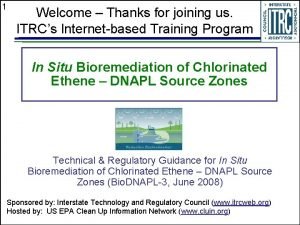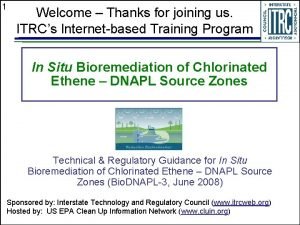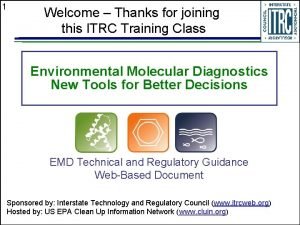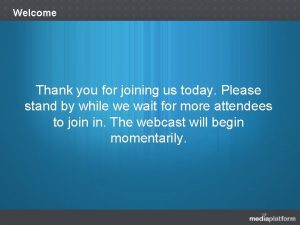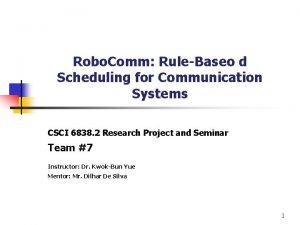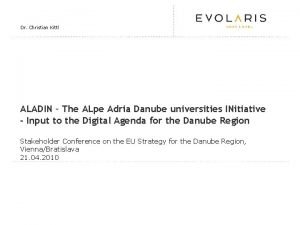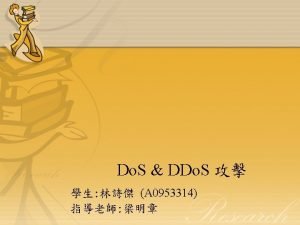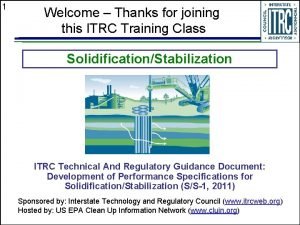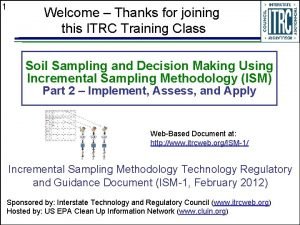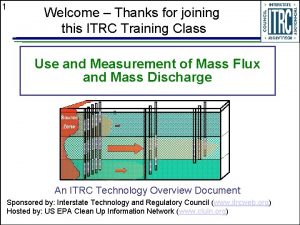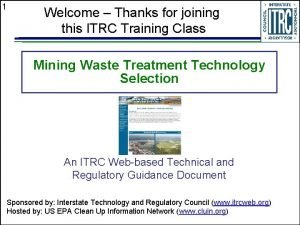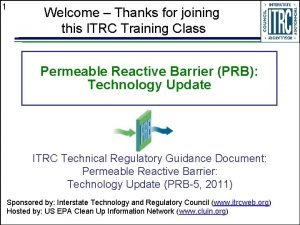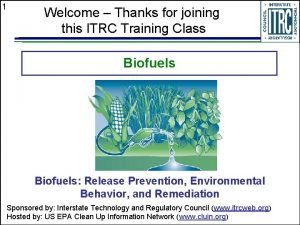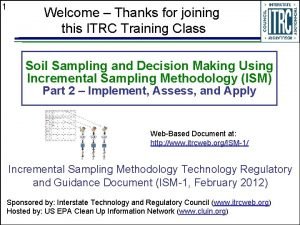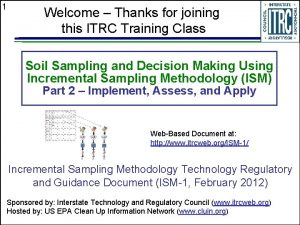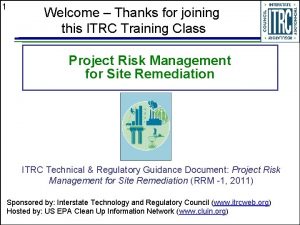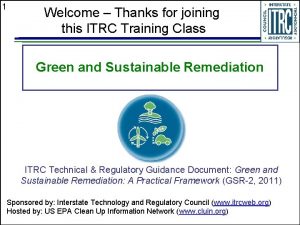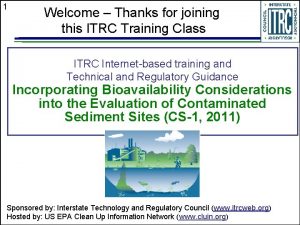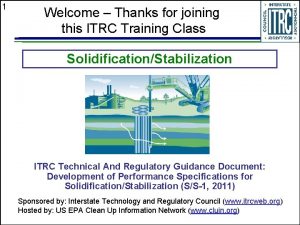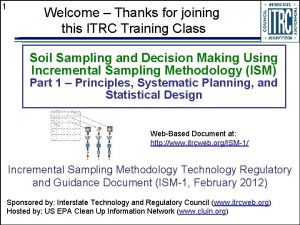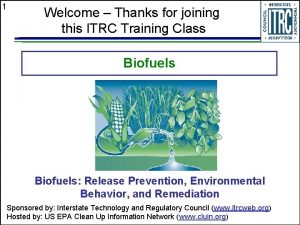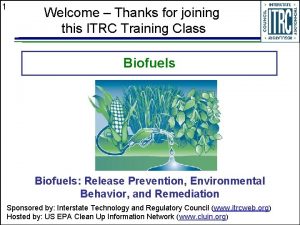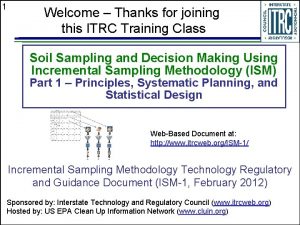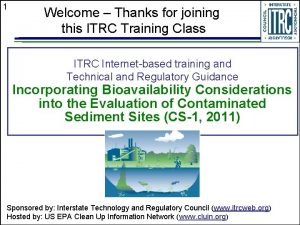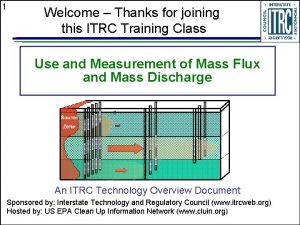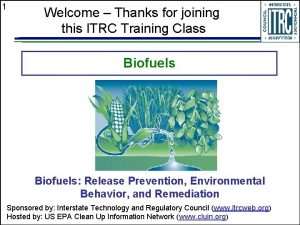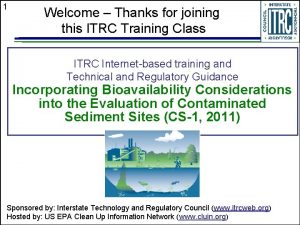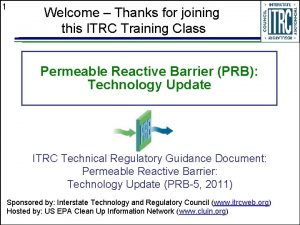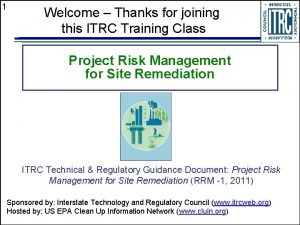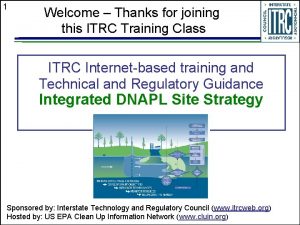1 Welcome Thanks for joining this ITRC Training




























































































- Slides: 92

1 Welcome – Thanks for joining this ITRC Training Class Green and Sustainable Remediation ITRC Technical & Regulatory Guidance Document: Green and Sustainable Remediation: A Practical Framework (GSR-2, 2011) Sponsored by: Interstate Technology and Regulatory Council (www. itrcweb. org) Hosted by: US EPA Clean Up Information Network (www. cluin. org)

2 Housekeeping u u Course time is 2¼ hours Question & Answer breaks • Phone - unmute #6 to ask • u question out loud Simulcast - ? icon at top to type in a question Turn off any pop-up blockers u u u Move through slides • Arrow icons at top of screen • List of slides on left Feedback form available from last slide – please complete before leaving This event is being recorded Download slides as PPT or PDF Go to slide 1 Move back 1 slide Move forward 1 slide Go to last slide Go to seminar homepage Submit comment or question Report technical problems Copyright 2013 Interstate Technology & Regulatory Council, 50 F Street, NW, Suite 350, Washington, DC 20001

3 ITRC (www. itrcweb. org) – Shaping the Future of Regulatory Acceptance u u Host organization Network • State regulators u Disclaimer • Full version in “Notes” section • Partially funded by the U. S. § All 50 states, PR, DC government • Federal partners § ITRC nor US government warrantee material § ITRC nor US government DOE DOD endorse specific products EPA • ITRC materials copyrighted • ITRC Industry Affiliates Program u Available from www. itrcweb. org • Technical and regulatory guidance documents • Academia • Community stakeholders • Internet-based and classroom training schedule • More…

4 Meet the ITRC Trainers Rebecca Bourdon Minnesota Pollution Control Agency 651 -757 -2240 rebecca. bourdon @state. mn. us Nick Petruzzi Cox-Colvin Associates 614 -526 -2040 nick_petruzzi @coxcolvin. com Karin Holland Haley & Aldrich, Inc. 619 -285 -7133 Kholland @haleyaldrich. com Elisabeth Hawley ARCADIS 510 -596 -9654 elisabeth. hawley @arcadis-us. com Stephanie Fiorenza BP America 281 -366 -7484 Stephanie. fiorenza @bp. com

5 Why Green and Sustainable Remediation (GSR)? u Improved stakeholder engagement • Community benefited from trails installed on new cap cover to river • Educational opportunities • Collaboration with local college u Simplified, reproducible results • Quantify desired metrics u Reduced impacts • Emissions/ greenhouse gases (GHGs) • Energy/Water/Waste • Ecosystems

6 GSR Training Roadmap Introduction (Section 1 Tech Reg) • Definitions • GSR Intent and Benefits GSR Framework GSR Planning (Section 2 Tech Reg) • Common Considerations • Relevant GSR Questions GSR Implementation (Section 3 Tech Reg) • Lifecycle Phase Approach • Consistent Methodology Q&A #1 GSR Tools (Section 4 Tech Reg) • Choosing the right tool • Examples of BMPs, Simple, and Advanced Tools Case Studies (Appendix C Tech Reg) Training Wrap-Up Q&A #2

7 ITRC's GSR Definition The site-specific employment of products, processes, technologies, and procedures that mitigate contaminant risk to receptors while making decisions that are cognizant of balancing community goals, economic impacts, and net environmental effects.

8 Green Remediation Reducing environmental impacts of common investigation and remediation activities

9 Green & Sustainable Remediation Environmental Economic Social

10 GSR Reality

11 ITRC GSR Products u Overview Document Green and Sustainable Remediation: State of the Science and Practice • (GSR-1, 2011) u Technical & Regulatory Guidance Document: Green and Sustainable Remediation: A Practical Framework • (GSR-2, 2011)

12 User Benefits of GSR Products Expected User Group Intended User Benefits Regulators Integrate GSR into site management decisions Better site decisions Consultants Integrate GSR into site recommendations Guide technology selection Site Owners Integrate GSR into site considerations Guide technology selection Academia Provide students with latest information Better equip students Community Stakeholders Provide trusted resource for decision-makers Contribute information to achieve the best remediation Protective solutions Better value for clients Regulatory partnership Better site decisions Possible savings

13 Snapshot Simple GSR Evaluation Petroleum Surface Soil Excavation Site GHG = greenhouse gas Option 1 Option 2 1. 5 ft. excavation w/ 6 in. excavation w/ gravel replacement concrete cap Option 3 6 in. excavation w/ asphalt cap Environmental 3 tons CO 2 4 tons GHG 2. 4 tons CO 2 11 tons GHG 2. 4 tons CO 2 >11 tons GHG Economic $16, 723 $21, 538 $15, 623 Social No aesthetic change Positive aesthetic change

14 GSR in Your Organization Framework u GSR Policy/Guidance integration or adaptation u How GSR fits into your agency/corporate strategic plan u

15 Learn to Apply GSR Concepts How to identify potential benefits? How to perform a GSR evaluation? How are similar programs applying GSR? When to incorporate GSR? Why conduct a GSR evaluation? Which tools are appropriate for your sites? GSR Answers How to apply this to your projects?

16 GSR Framework GSR Planning Evaluate/Update Conceptual Site Model Establish GSR Goals Stakeholder Involvement Select Metrics, Evaluation Level, Boundaries Document GSR Efforts + GSR Implementation Identifying GSR Options Performing GSR Evaluations Implementing GSR Approaches Monitoring, Tracking, and Documentation Investigation Closeout Remedy Optimization Remedy Evaluation and Selection Remedy Design Remedy Operation, Maintenance, Construction and Monitoring = GSR Framework

17 GSR Framework Flexible and Scalable Flexibility similar to that found in conceptual remedial designs u Scalable to the size and level-of-detail of the project u Example: UST site vs. Superfund site

18 GSR Training Roadmap Introduction (Section 1 Tech Reg) • Definitions • GSR Intent and Benefits GSR Framework GSR Planning (Section 2 Tech Reg) • Common Considerations • Relevant GSR Questions GSR Implementation (Section 3 Tech Reg) • Lifecycle Phase Approach • Consistent Methodology Q&A #1 GSR Tools (Section 4 Tech Reg) • Choosing the right tool • Examples of BMPs, Simple, and Advanced Tools Case Studies (Appendix C Tech Reg) Training Wrap-Up Q&A #2

19 Plan and Incorporate GSR into Your Project GSR

20 GSR Planning Tech Reg Section 2

21 GSR Planning Evaluate/Update Conceptual Site Model (CSM) Evaluate/Update Conceptual Site Model u u Establish GSR Goals u Stakeholder Involvement Select Metrics, GSR Evaluation Level, Boundaries Document GSR Efforts Evaluate and update as necessary Integrate relevant GSR information to reflect potential opportunities were GSR can be considered and implemented CSM similar to that discussed in ITRC Performance Based Environmental Management Document (RPO-7)* *http: //www. itrcweb. org/Documents/RPO-7. pdf

22 GSR Planning Establish GSR Goals Evaluate/Update Conceptual Site Model u u u Establish GSR Goals u Stakeholder Involvement Select Metrics, GSR Evaluation Level, Boundaries Document GSR Efforts u Site setting and circumstances GSR components EPA’s green remediation core elements* Drivers: regulatory guidance/policy, corporate directives, incentives Goals can relate to remediation and non-remediation activities *www. clu-in. org/greenremediation

23 GSR Planning Stakeholder Involvement Evaluate/Update Conceptual Site Model u u Establish GSR Goals u Stakeholder Involvement u Select Metrics, GSR Evaluation Level, Boundaries u Document GSR Efforts u Key consideration of sustainable remediation GSR stakeholders are typically a subset of the project stakeholders New stakeholders may be identified solely on GSR interest Engage at appropriate points during the cleanup project For GSR, stakeholder involvement should be more frequent or to a greater effort than required by regulatory program Includes GSR and non-GSR information

24 GSR Planning Stakeholder Involvement Examples Stakeholder involvement can be interpreted and fulfilled in many different ways u Remedy Construction Example: distribution of information by monthly newsletter u Remedy Evaluation & Selection Example: interactive dialogue pertaining to limiting excavation

25 GSR Planning Select Metrics, GSR Evaluation Level, Boundaries Evaluate/Update Conceptual Site Model u u Establish GSR Goals u u Stakeholder Involvement u Select Metrics, GSR Evaluation Level, Boundaries Document GSR Efforts Establish metric(s) for each GSR goal Consider boundary conditions, funding, contracts, schedule, experience Quantitative vs. qualitative metrics Some metrics identified in Table 4 -1 of GSR Overview Document (GSR-1)* and SURF Metrics Toolbox** Select GSR Evaluation Level – three levels of detail/complexity *www. itrcweb. org/Documents/GSR-1. pdf **www. sustainableremediation. org/library

26 GSR Planning Metric Examples from Part of Table 4 -1 in GSR-1 Economic Community Waste Water Land Metric Fresh Water Consumption Biodiversity Metric Units gallons Metric Description volume of fresh water used species count assessment of impacts on biodiversity measure of use of renewable energy tons of GHGs emitted Renewable Energy Use Greenhouse Gas Emissions gallons; BTU; k. Wh Material Use Kg Employment jobs created Capital Costs $ Community Impacts Cultural Resources subjective CO 2 equivalents emitted subjective kg of total material use, or mass by category of material number of jobs created as a result of implementing remedy capital costs of project impacts of project on the community impacts of project on cultural resources

27 GSR Planning GSR Evaluation Levels LEVEL 3 BMPs + Advanced Evaluation LEVEL 2 BMPs + Simple Evaluation LEVEL 1 Best Management Practices (BMPs)

28 GSR Planning Document GSR Efforts Evaluate/Update Conceptual Site Model u u Establish GSR Goals Stakeholder Involvement u Select Metrics, GSR Evaluation Level, Boundaries u Document GSR Efforts Critical to GSR goals and stakeholder communication Planning and field work records, GSR evaluation reports, progress updates, etc. Document assumptions, resources, tools, goals, metrics, constraints/barriers, etc. Phase-specific examples in Tech Reg Section 3

29 GSR Planning Brownfield Investigation Phase Example Stakeholder Involvement Conduct kick-off meeting Preliminary greenspace plan Establish GSR Goals Reduce investigation derived waste and fuel consumption; minimize greenspace disturbance Select Metrics, GSR Evaluation Levels, Boundaries Gallons of purge water, drums of soil cuttings, travel miles; Level 2 evaluation; onsite + travel Execution using GSR Implementation Process Evaluate/Update Conceptual Site Model Update CSM (sample data, rail spur, nearby recycler, current greenspace) Document GSR Efforts BMPs, field logs, meeting minutes, GSR evaluation report

30 GSR Training Roadmap Introduction (Section 1 Tech Reg) • Definitions • GSR Intent and Benefits GSR Framework GSR Planning (Section 2 Tech Reg) • Common Considerations • Relevant GSR Questions GSR Implementation (Section 3 Tech Reg) • Lifecycle Phase Approach • Consistent Methodology Q&A #1 GSR Tools (Section 4 Tech Reg) • Choosing the right tool • Examples of BMPs, Simple, and Advanced Tools Case Studies (Appendix C Tech Reg) Training Wrap-Up Q&A #2

31 GSR Implementation Tech/Reg Section 3 u Identifies how GSR approaches may be Selected Implemented Evaluated Covers each remediation phase u Provides a flexible approach u

32 Remediation Phases Investigation (Section 3. 1) Remedy Evaluation and Selection (Section 3. 2) Remedy Design (Section 3. 3) Remedy Construction (Section 3. 4) Operation, Maintenance, and Monitoring (Section 3. 5) Remedy Optimization (Section 3. 6) Closeout (Section 3. 7)

33 How Does GSR Fit In? Investigation • GSR application during planning Remedy Evaluation and Selection • Ideal point for incorporating GSR Remedy Design Remedy Construction Operation, Maintenance and Monitoring Remedy Optimization Closeout • Integration of GSR into selected remedy • GSR integral part of remedy • Cumulative benefits resulting from GSR • Sustainability performance improvement for existing remedies • Support for site reuse

34 Relationships with Existing Programs ITRC GSR-2: Table 3. 1 (excerpt) u Can be applied to any federal or state program Remedial Phase RCRA CERCLA State Programs LUST RCRA Facility Investigation Remedial Investigation Site Assessment Remedial Investigation; Secondary Investigation Remedy Evaluation and Selection Corrective Measures Study and Statement of Basis Feasibility Study, Proposed Plan, and Record of Decision Remedial Alternative Evaluation Conceptual Corrective Action Design; Corrective Action Plan Remedy Design Corrective Measures Design/Corrective Measures Implementation Work Plan; Interim Measure Remedial Design Remedial Action Plan; Interim Source Removal Plan Focused Investigation, Detailed Corrective Action Design Investigation

35 Approach u u Consistent for each phase Provides a methodology for

36 GSR Options Sustainable BMP Examples Minimize impacts to natural resources Engage stakeholde rs Identify recycling/ reuse options Maximize renewable energy use Use local labor and resources Reuse unimpacte d soil

37 GSR Options Remedy Construction Example Environmental - Minimize idling - Control/mitigate dust and odors - Conduct air monitoring - Set up an on-site recycling program - Minimize fuel/energy use ITRC GSR-2: Table 3. 7 Social - Implement community notifications - Conduct community meetings - Post information on project progress - Maximize use of local businesses - Sequence construction activities Economic - Consider economic benefits to community

38 GSR Evaluation Levels LEVEL 3 BMPs + Advanced Evaluation LEVEL 2 BMPs + Simple Evaluation LEVEL 1 Best Management Practices (BMPs)

39 GSR Evaluation Level 1 Example Operation, maintenance, and monitoring example BMPs u Select local contractors u Minimize mobilizations u Engage the local community u Use renewable energy u Reduce noise, especially beyond site boundary u Implement land revitalization opportunities

40 GSR Evaluation Level 2 Example Hypothetical Remedy Evaluation and Selection Performing GR evaluations In Situ Thermal Bioremediation In Situ Chemical Oxidation Sensitive species Community disturbance Community acceptance Cost Metric Greenhouse gases Solid waste

41 GSR Evaluation Level 3 Example Hypothetical Investigation Metric Approach 1 Approach 2 Carbon dioxide 2 metric tons 1. 5 metric tons Investigation Derived Waste 1, 750 pounds 1, 230 pounds Waste Water 500 gallons 390 gallons Local Economy Benefit $62, 000 $35, 000 Cost $120, 000 $85, 000

42 GSR Implementation Phase-specific u Incorporate GSR options and evaluation results u Ensure team understands GSR elements u Estimate benefits u Involve stakeholders u

43 GSR Implementation Closeout Example Implement GSR evaluation recommendations u Incorporate GSR aspects into u • Procurement documents • Field work plans u Ensure contractors understand GSR practices

44 GSR Implementation Benefits Remedy Optimization Example u u VOC concentrations to an air stripper dropped significantly Unit downsized from 20 to 10 HP motor 1. 7 M KWh saved! GHG emissions reduced by 1, 080 metric tons! $168 K cost savings!

45 Tracking and Documentation Ensures transparency u Documents GSR practices u Identifies sustainability benefits u Tracks successes and lessons learned u Incorporated in regulatory reports u

46 Documentation BMPs selected u Evaluation level performed u GSR implementation u Stakeholder collaboration efforts u Monitoring and tracking results u Data collected u

47 GSR Implementation Summary u Consistent methodology for

48 GSR Implementation Example Remedy Evaluation and Selection - In situ/on-site remedies - Renewable energy - Waste minimization e. g. , Level 3 Remedy that - Reduces footprint - Acceptable to stakeholders - Achieves economic goals - Monitor GSR implementation - Communicate results

49 1 st Question and Answer Session Introduction (Section 1 Tech Reg) • Definitions • GSR Intent and Benefits GSR Framework GSR Planning (Section 2 Tech Reg) • Common Considerations • Relevant GSR Questions GSR Implementation (Section 3 Tech Reg) • Lifecycle Phase Approach • Consistent Methodology Q&A #1 GSR Tools (Section 4 Tech Reg) • Choosing the right tool • Examples of BMPs, Simple, and Advanced Tools Case Studies (Appendix C Tech Reg) Training Wrap-Up Q&A #2

50 GSR Training Roadmap Introduction (Section 1 Tech Reg) • Definitions • GSR Intent and Benefits GSR Framework GSR Planning (Section 2 Tech Reg) • Common Considerations • Relevant GSR Questions GSR Implementation (Section 3 Tech Reg) • Lifecycle Phase Approach • Consistent Methodology Q&A #1 GSR Tools (Section 4 Tech Reg) • Choosing the right tool • Examples of BMPs, Simple, and Advanced Tools Case Studies (Appendix C Tech Reg) Training Wrap-Up Q&A #2

51 Before Selecting GSR Tools Set GSR Goals and Select Metrics Goals Metrics Example Goals Example Metrics Reduce emissions Greenhouse gases Air quality emissions Conserve natural resources Energy and water use Create habitat Ecological service value Improve community Traffic volume Resource consumption Jobs for local workers Tools

52 Before Selecting GSR Tools Evaluate Project Scope Stakeholders Values GSR Metrics Project leader Project efficiency Energy & cost savings Property value Land use Community group Safety and quality of life Traffic volume Site regulator Health and environment Air pollutant emissions Property owner Ecological habitat

53 Before Selecting GSR Tools Set Boundaries for GSR Evaluation On-Site Impacts System construction materials Land footprint Electricity used Off-Site Impacts Materials used Air pollution n o i t a t r po s n a r T Fuel consumption Air pollution Traffic volume Extracted water Treated water discharge Construction materials Treatment media (carbon)

54 Tool Selection Considerations u Consider • Site-specific GSR goals and metrics • Scope, budget, and purpose of GSR evaluation • Available site data • Type of remediation technologies • Regulatory cleanup program No certification or standard evaluation method u ITRC team does not endorse any specific GSR tool u

55 Tool Selection Wide Range of Available Tools Choose simplest tool that gets the job done u BMPs (Level 1) are most often used u Increasing Tool Complexity and Data Needs LEVEL 3 BMPs + Advanced Evaluation LEVEL 2 BMPs + Simple Evaluation LEVEL 1 Best Management Practices (BMPs)

56 Tool Selection Select the Right Level of Evaluation Level 1 BMPs Level 2 BMPs + Simple Level 3 BMPs + Advanced Description • Best practices (e. g. , no idling of truck engines at job site) • Qualitative ranking process • Quantitative analysis (e. g. , footprint analysis, Net Environmental Benefits Analysis) Pros • Simple • Cost-effective • Easy to implement • Evaluates multiple metrics • Simple calculations only (lb CO 2/lb contaminant treated) • Quantifies multiple metrics • Track impacts from cradle to cradle Cons • Does not evaluate trade-offs • Requires scoring method • More costly, timeconsuming • More data required

57 GSR Tools BMPs (Level 1) ASTM, EPA, SURF, USACE u EPA fact sheets u • • Introduction to BMPs Site investigation Excavation Pump-and-treat Bioremediation SVE/air sparging Clean fuel and emission technologies • Renewable energy http: //www. clu-in. org/greenremediation/

58 GSR Tools Simple Tools (Level 2) u California Department of Toxic Substances Control Green Remediation Evaluation Matrix (GREM) Metrics Option 1 - SVE Option 2 - MNA Yes/No Score* Relative Importance Air emissions Yes 2 Yes 1 1 Solid waste Yes 2 Yes 1 1 Wastewater Yes 1 1 Noise/odor/vibration Yes 3 Yes 1 1 Land stagnation Yes 1 Yes 3 2 TOTAL 9 7 WEIGHTED TOTAL 10 10 *Scale of 1 to 3 where 1 is favorable (more green or sustainable) in this example http: //www. dtsc. ca. gov/omf/grn_remediation. cfm

59 GSR Tools Advanced Tools (Level 3) Carbon footprint calculators u Remedy footprint tools u • Air Force Sustainable Remediation Tool (SRTTM) • Navy and Army Corps of Engineers Site. Wise. TM • Other tools Net environmental benefits analysis tools u Life-cycle assessment (LCA) tools u

60 GSR Tools Sustainable Remediation Tool (SRT)TM Use for remedy selection and optimization u Two choices for level of detail u Eight technologies u Measures air emissions, greenhouse gas emissions, energy, cost, accident risk, change in resource use u Stakeholder scoring matrix u http: //www. afcee. af. mil/resources/technologytransfer/programsandinitiatives/ sustainableremediation/srt/index. asp

61 GSR Tools SRTTM General Inputs Plume size Contaminant concentrations Aquifer properties http: //www. afcee. af. mil/resources/technologytransfer/programsandinitiatives/ sustainableremediation/srt/index. asp

62 GSR Tools SRTTM Results Technologies Metrics http: //www. afcee. af. mil/resources/technologytransfer/programsandinitiatives/ sustainableremediation/srt/index. asp

63 GSR Tools Site. Wise. TM u Spreadsheet for each stage of remedial action • • u Remedial investigation Remedy construction Remedy operation Long-term monitoring Activities in each stage • • Material production Transportation Equipment used Waste handling http: //www. ert 2. org/t 2 gsrportal/Site. Wise. aspx

64 GSR Tools Site. Wise. TM General Inputs Example: Materials Production Well materials Treatment chemicals Granular activated carbon Construction materials http: //www. ert 2. org/t 2 gsrportal/Site. Wise. aspx Item 1, Item 2

GSR Tools Site. Wise. TM Results Remedial Alternative Emissions (Metric Tons) Energy (MMBTU) Alternative 1 Alternative 3 Alternative 4 Alternative 5 Alternative 6 Comparative graph generated for each metric http: //www. ert 2. org/t 2 gsr portal/Site. Wise. aspx GHGs 300 140 80 380 550 3. 05 0. 22 NOx SOx 0 0 0 6. 0 E-05 0 0 0 1. 0 E-06 Accident Risk Injury 0 0 0 3. 14 E-06 GHG Emissions 600 Metric Tons 65 400 200 0 1 3 4 5 Remedial Alternative 6

66 GSR Tools Other Remedy Footprint Tools u Other footprint tools and methodologies • • • u Private industry/consulting firms Universities States EPA tools DOE Other organizations Potential benefits • Technology modules • Simplified tracking for a portfolio of sites • Biofuels, renewable energy options ITRC GSR-1: Appendix A

67 GSR Tools Life Cycle Assessment (LCA) Process LCA Process u Example tools Define goals, scope and functional unit • Sima. Pro® • Ga. Bi Establish metrics and system boundaries u Can be used to evaluate wide range of metrics u Draw from variety of emissions inventory databases u Provide different methods for impact assessment u ITRC GSR-2 Section 4 and SURF, 2011 Compile project inventory Assess impacts Analyze sensitivity Interpret and report results

68 GSR Tools Weighting and Scoring Methods Some tools give you an overall GSR score u Decide relative importance of each GSR metric u Normalize to common units and range u • Common denominator (e. g. , $) • Common range (e. g. , 1 to 100) based on min/max or mean/ standard deviation u No “perfect” approach Tool Output

69 GSR Tools Best Practices Use BMPs u Select the simplest evaluation needed for the job u Involve stakeholders in process u Evaluate the uncertainty/sensitivity of results u Document GSR evaluation process u

70 GSR Training Roadmap Introduction (Section 1 Tech Reg) • Definitions • GSR Intent and Benefits GSR Framework GSR Planning (Section 2 Tech Reg) • Common Considerations • Relevant GSR Questions GSR Implementation (Section 3 Tech Reg) • Lifecycle Phase Approach • Consistent Methodology Q&A #1 GSR Tools (Section 4 Tech Reg) • Choosing the right tool • Examples of BMPs, Simple, and Advanced Tools Case Studies (Appendix C Tech Reg) Training Wrap-Up Q&A #2

71 Case Studies Application of Green & Sustainable Remediation to sites u Examples with different u • • GSR levels Remediation phases Metrics Regulatory programs Environmental Economic Social

72 Former Refinery Site (Level 1) Overview Pre-GSR: no formal evaluation for selection of optimization measures u GSR scope: applied during Remedy Optimization u GSR metrics u • Energy consumption • Ecological diversity • Community benefits ITRC GSR-2: Appendix C

73 Former Refinery Site (Level 1) Site Remediation Setting u u Superfund, US EPA Region 2 and NYS DEC Site type: Former Refinery Hydrocarbon impacted groundwater Remediation driver • River downgradient u Existing remedy • Chemical treatment of extracted groundwater u Optimized remedy • Constructed wetland for treatment of extracted groundwater Vertical Flow Wetland

74 Former Refinery Site (Level 1) Existing Conditions Planned Restoration Conditions

75 Former Refinery Site (Level 1) Significant GSR Elements u Environmental • In situ treatment via constructed wetland • Biodiversity • Reduced chemical use and energy consumption u Social • Community access § Bird watching stations and hiking trail • Education § Environmental center with state college u Economic • Cost savings

76 Former Refinery Site (Level 1) Summary u Benefits of GSR approach • Wetland reduced treatment chemical use and energy consumption and increased biodiversity • Communication between site owner and community improved through meetings, website, and newsletters • Better connection to natural environment • Improved educational opportunities u Challenge to incorporating GSR • Regulatory – changing a record of decision (ROD) remedy through an explanation of significant difference (ESD) rather than a ROD amendment u Lessons learned • Communication with stakeholders is key to successful outcome

77 RCRA Site (Level 2) Overview u Evaluation method • Qualitative and quantitative during remedy selection • Professional judgment and BMPs during all phases u GSR scope • Applied from Site Assessment through Remedy Selection, Design and Construction u GSR metrics • • • Carbon dioxide (CO 2) emissions Waste minimization and reuse Consumption of resources Community benefits Corporate sustainability goals

78 RCRA Site (Level 2) Site Remediation Setting u State RCRA program, confidential location Permeable sand glacial outwash with glacial till near surface 39 volatile and semivolatile organic compounds (VOCs) + (SVOCs) in subsurface soil and perched groundwater Remediation driver u Remedy selected u u u • Sole source aquifer • Source excavation of 70, 000 tons u Other remedies considered • Ex situ thermal • In situ electrical resistive heating (ERH) and hot spot excavation

RCRA Site (Level 2) Significant GSR Elements Utilized u Environmental • • u Triad for assessment Efficient trip routing No idling Reduced CO 2 emissions Social • Communication • Reduced nuisance u Economic • Time to completion 6300 CO 2 Emissions (ton) 79 5850 500 Excavation Ex situ Thermal In situ ERH & Excavation Potential Remedial Alternatives

80 RCRA Site (Level 2) Summary u Benefits of GSR approach • Reduced energy consumption and CO 2 emissions • Positive relations with stakeholders u Challenges to implementation of GSR • Selection of an appropriate GSR evaluation approach • Weighting of metrics • Lack of incentives and recognition for facility u Lessons learned • Clear communication and documentation key • Construction worker/contractor understanding of GSR benefits may take time

81 Brownfield Site (Level 3) Overview u u Picnic Grove And Picnic Lawn Multiuse 200 -slip Marina Trails and Overloo ks Restaura nt & Marina Services Restored Evaluation method: Wetlands Site. Wise™ and Sustainable Remediation Tools™ (SRT™) GSR scope: applied during Site Assessment and Remedy Selection GSR metrics: energy consumption, air emissions (including GHG), water consumption, accident risk, cost savings GSR boundaries: both tools Pedestria Softball, Public 18 -Hole Multin Basketball Library/Commu Miniatur use account for material Bridge and nity Center e Golf Sports connecti Playgroun Course Field manufacturing and site ng to ds North impacts Camden Cooper’s Ferry Development Corp Source: High Point Viewing Area

82 Brownfield Site (Level 3) Site Remediation Setting u u u NJDEP Brownfield Site Former Landfill - chlorinated benzenes impacting soil and groundwater Remediation Driver: Redevelopment Interim Remedy Selected: Excavation Other Remedies Considered: in situ chemical oxidation (ISCO), in situ thermal remediation (ISTR) Landfill waste Gray/black clay Silt with sand Medium-fine sand Red/brown clay

83 Brownfield Site (Level 3) Significant GSR Elements u Environmental • Triad - Membrane Interface Probe • Biofuels • Footprint/Tool Comparison u Social • Revitalize blighted neighborhood • Reduce accident risk u Economic • Leverage public/private investment for future redevelopment

84 Brownfield Site (Level 3) Site. Wise™ Output GHG Emissions Total energy Used Water Consumption NOx Emissions metric tons MMBTU gallons metric tons Consumables 108. 18 1. 00 E+03 NA NA NA Transportation. Personnel 19. 35 2. 20 E+02 NA 3. 30 E+01 6. 90 E+00 1. 60 E+00 1. 20 E-04 8. 30 E-03 Transportation. Equipment 0 0. 00 E+00 NA 0. 00 E+00 Equipment Use and Misc 2, 856. 43 5. 70 E+04 2. 80 E+06 4. 10 E+00 1. 90 E+01 9. 90 E-04 1. 60 E-05 7. 00 E-03 0. 71 1. 70 E+01 NA 7. 60 E-04 1. 80 E-04 1. 10 E-04 1. 90 E-06 3. 90 E-04 2, 984. 67 5. 81 E+04 2. 80 E+06 3. 69 E+01 2. 63 E+01 1. 57 E+00 1. 38 E-04 1. 56 E-02 Activities Residual Handling Total Sustainable Remediation 2011, UMASS Amherst SOx Emissions PM 10 Emissions Accident Risk Injury Fatality metric tons NA NA NA

85 Brownfield Site (Level 3) Summary u Benefits of GSR approach • Triad process expedited investigation and redevelopment, improved remediation • Community institutions were strengthened • Air emissions (including GHG) were reduced • Project catalyzed neighborhood revitalization and job creation will reduce poverty u Challenge to implementing GSR • Weighting social, economic and environmental metrics was difficult u Lessons learned • Tool selection depends on amount of information available and technologies being evaluated

86 Key Lessons from Case Studies Flexibility: GSR process can be applied to a variety of sites, remediation phases and regulatory programs u Communication: Communication with stakeholders is critical to successful application of GSR u Assumptions: Because evaluation methods are new, users must understand the assumptions of the tools being used u Holistic: This holistic approach will minimize a project’s life cycle impacts u

87 GSR Training Wrap-Up Introduction (Section 1 Tech Reg) • Definitions • GSR Intent and Benefits GSR Framework GSR Planning (Section 2 Tech Reg) • Common Considerations • Relevant GSR Questions GSR Implementation (Section 3 Tech Reg) • Lifecycle Phase Approach • Consistent Methodology GSR Tools (Section 4 Tech Reg) • Choosing the right tool • Examples of BMPs, Simple, and Advanced Tools Case Studies (Appendix C Tech Reg) Training Wrap-Up

88 GSR Maturation Environmental Economic Environmental Social Economic Theory Social Present Economic Social GSR Potential ITRC GSR-2: Figure 1 -2 Adapted from International Union for Conservation of Nature, 2006

89 Remedial Industry GSR Growth Regulatory Recommended GSR Guidance User-Defined Voluntary GSR Considerations Policy Discussion

90 Relationship to Other GSR Efforts Information clearinghouse, Core Elements, fact sheets, best management practices, standard guide Detailed information specific to metrics, framework, and life-cycle assessment White papers, BMPs, and incentives Sustainable Remediation Tool. TM, Site. Wise. TM Tool, Fact Sheets, Case Studies Practical guidance with a framework, metrics and tools for remedial practitioners

91 Concluding Statements u Make the ITRC GSR Framework your own u GSR potential is limitless u Top-down or bottom-up, integration is possible u Share your successes!

92 Thank You for Participating u 2 nd question and answer break u Links to additional resources • http: //www. clu-in. org/conf/itrc/gsr/resource. cfm u Feedback form – please complete • http: //www. clu-in. org/conf/itrc/gsr/feedback. cfm Need confirmation of your participation today? Fill out the feedback form and check box for confirmation email.
 Welcome thanks for joining us
Welcome thanks for joining us Itrcs
Itrcs Welcome thanks for joining us
Welcome thanks for joining us Sip bio-trap
Sip bio-trap Video platform
Video platform Welcome thank you for joining us
Welcome thank you for joining us Welcome welcome this is our christmas story
Welcome welcome this is our christmas story Fspos vägledning för kontinuitetshantering
Fspos vägledning för kontinuitetshantering Typiska novell drag
Typiska novell drag Tack för att ni lyssnade bild
Tack för att ni lyssnade bild Returpilarna
Returpilarna Varför kallas perioden 1918-1939 för mellankrigstiden?
Varför kallas perioden 1918-1939 för mellankrigstiden? En lathund för arbete med kontinuitetshantering
En lathund för arbete med kontinuitetshantering Personalliggare bygg undantag
Personalliggare bygg undantag Tidbok yrkesförare
Tidbok yrkesförare Sura för anatom
Sura för anatom Densitet vatten
Densitet vatten Datorkunskap för nybörjare
Datorkunskap för nybörjare Tack för att ni lyssnade bild
Tack för att ni lyssnade bild Debattartikel struktur
Debattartikel struktur Autokratiskt ledarskap
Autokratiskt ledarskap Nyckelkompetenser för livslångt lärande
Nyckelkompetenser för livslångt lärande Påbyggnader för flakfordon
Påbyggnader för flakfordon Lufttryck formel
Lufttryck formel Publik sektor
Publik sektor I gullregnens månad
I gullregnens månad Presentera för publik crossboss
Presentera för publik crossboss Argument för teckenspråk som minoritetsspråk
Argument för teckenspråk som minoritetsspråk Kanaans land
Kanaans land Treserva lathund
Treserva lathund Mjälthilus
Mjälthilus Bästa kameran för astrofoto
Bästa kameran för astrofoto Cks
Cks Verifikationsplan
Verifikationsplan Mat för idrottare
Mat för idrottare Verktyg för automatisering av utbetalningar
Verktyg för automatisering av utbetalningar Rutin för avvikelsehantering
Rutin för avvikelsehantering Smärtskolan kunskap för livet
Smärtskolan kunskap för livet Ministerstyre för och nackdelar
Ministerstyre för och nackdelar Tack för att ni har lyssnat
Tack för att ni har lyssnat Hur ser ett referat ut
Hur ser ett referat ut Redogör för vad psykologi är
Redogör för vad psykologi är Matematisk modellering eksempel
Matematisk modellering eksempel Tack för att ni har lyssnat
Tack för att ni har lyssnat Borra hål för knoppar
Borra hål för knoppar Orubbliga rättigheter
Orubbliga rättigheter Formel standardavvikelse
Formel standardavvikelse Tack för att ni har lyssnat
Tack för att ni har lyssnat Steg för steg rita
Steg för steg rita Informationskartläggning
Informationskartläggning Tobinskatten för och nackdelar
Tobinskatten för och nackdelar Blomman för dagen drog
Blomman för dagen drog Handledning reflektionsmodellen
Handledning reflektionsmodellen Egg för emanuel
Egg för emanuel Elektronik för barn
Elektronik för barn Vad kallas den mantel som bars av kvinnor i antikens rom
Vad kallas den mantel som bars av kvinnor i antikens rom Strategi för svensk viltförvaltning
Strategi för svensk viltförvaltning Kung som dog 1611
Kung som dog 1611 Ellika andolf
Ellika andolf Sju för caesar
Sju för caesar Tack för att ni lyssnade
Tack för att ni lyssnade Multiplikation med uppställning
Multiplikation med uppställning Dikter om vänskap
Dikter om vänskap Inköpsprocessen steg för steg
Inköpsprocessen steg för steg Rådet för byggkompetens
Rådet för byggkompetens Etik och ledarskap etisk kod för chefer
Etik och ledarskap etisk kod för chefer Kolposkopi px
Kolposkopi px Myndigheten för delaktighet
Myndigheten för delaktighet Frgar
Frgar Sju principer för tillitsbaserad styrning
Sju principer för tillitsbaserad styrning Läkarutlåtande för livränta
Läkarutlåtande för livränta Karttecken brant
Karttecken brant Lek med former i förskolan
Lek med former i förskolan Shivaismen
Shivaismen Var finns arvsanlagen
Var finns arvsanlagen Bris för vuxna
Bris för vuxna Big brother rösta
Big brother rösta Welcome to the training session
Welcome to the training session Alleluia alleluia give thanks to the risen lord lyrics
Alleluia alleluia give thanks to the risen lord lyrics American satan cda
American satan cda Thank you for you listening
Thank you for you listening Thanks for listen
Thanks for listen Gustation and olfaction
Gustation and olfaction Thanks for listening
Thanks for listening How to reply thanks
How to reply thanks Thanks any question
Thanks any question Give thanks to the lord our god and king
Give thanks to the lord our god and king Blie danube
Blie danube Thanks to god for my redeemer
Thanks to god for my redeemer Oh give thanks to the lord for he is good
Oh give thanks to the lord for he is good Thanks for your attention!
Thanks for your attention! 謝千萬聲
謝千萬聲 The end thanks for listening
The end thanks for listening

